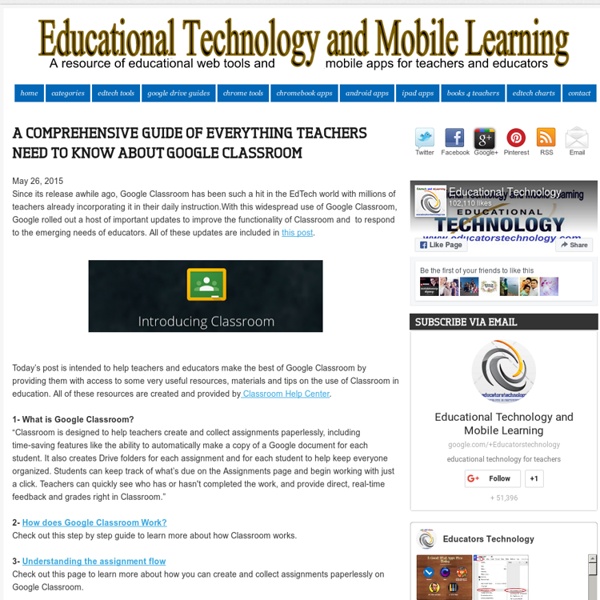A Comprehensive Guide of Everything Teachers Need to Know about Google Classroom

http://www.educatorstechnology.com/2015/05/a-comprehensive-guide-of-everything-teachers-need-to-knw-about-google-classroom.html
Related: Classroom/Gsuite
One Example of a “Bad Hint”
A couple of weeks ago during the Sunday night #probchat on Twitter the topic of hints came up. (You can read the whole conversation at Storify.) A few people started talking about possible “good” and “bad” hints, and I wondered how we’d gotten onto the topic of hints, rather than talking about possible solution strategies (which was the current question posed in the chat). So I chimed in with
Google Keep - Rid yourself of scrawled notes and reminders! - Everything Google
In addition to simple notes, if you click the New List icon, you can create lists that you can check off as you complete tasks. Any of your notes can be shared with others, just by clicking on the Share button .
5 Tips to Implement Google Drive in the Classroom - EDUSPIRE
If you haven’t used Google Drive to manage student work in the past Google is sure making it difficult to ignore in the future. Why not explore a few of these management tips before the end of the school year so you can make it part of your plan for next year? Name and share a resource folder How?
Google for Education: New ways to integrate with Google Classroom
Posted by Pepper Lebeck-Jobe, Classroom API Tech Lead (Cross-posted on the Google for Work Blog.) Classroom debuted last year to help teachers and students save time and collaborate with each other, and since then we’ve been working on how to make sure it worked well with other products that educators love and use in their classes.
Responding to Student Progress
One area where I need a lot of growth is responding to the progress of my students. Specifically, what are the next steps after I’ve identified the level of understanding in certain concepts? I recently decided to tackle this challenge during our review days for the state assessment.
80+ Google Forms for the Classroom
If you're new here, you may want to subscribe to my weekly newsletter. Thanks for visiting! Google Forms is a great tool for the classroom and this post from 2008 has always proven popular on my blog.
Google for Education: Google Classroom: Basics
Students have an entirely different view of Classroom than teachers. But it is equally as easy to use. Students can join classes, communicate with their teachers, turn in assignments, and even revise work that has already been turned in. Add a class A teacher can directly add a student to a class, or give them the class code to join themselves. The following instructions are from the point of view of a student in Classroom.
Finally! Google Classroom Lets You Share With Parents
The complaint about Google Classroom that I've heard more than any other over the last couple of years has been, "parents can't see what's happening." Today, Google finally did something about that. You can now invite parents and guardians to subscribe to a daily or weekly summary of activities in your Google Classroom classes. Initiating the process of sharing summaries with parents and guardians does require cooperation on the part of your school's administrator.
NCTM Brain Teasers
Sliding Triangle The triangle at left lies on a flat surface and is pushed at the top vertex. The length of the congruent sides does not change, but the angle between the two congruent sides will increase, and the base will stretch. Initially, the area of the triangle will increase, but eventually the area will decrease, continuing until the triangle collapses. What is the maximum area achieved during this process?
Related:



